When trying to drive change on tough social and business issues, are leaders best served by framing their case in moral or economic terms?
It is a question that has been playing out in discussions about workplace diversity, equity and inclusion (DEI) over recent years. Extensive research has built an ever-stronger economic case. Organizations with the most diverse leadership teams have consistently been shown to out-perform their rivals; inclusive organizations are likely to reap the rewards of higher employee engagement and loyalty; those that create environments where employees feel psychologically safe do better in unlocking innovation and top-level performance.
Yet recent years have also reminded us of the sheer force of moral arguments for action: that it is, quite simply, right to act. #MeToo highlighted how far there is still to go on equality for women; while in 2020, violence in the US sparked global protests against racial injustice. At the same time, Covid-19 has typically hit minorities and the poorest in society hardest in countries around the world.
So to the question ‘morality or economics?’, the answer surely has to be: both. The case for change is moral and economic. The two go hand in hand. We should expect our workplaces to reflect accurately our diverse societies; we can demand greater diversity in leadership roles; we must insist on inclusive and fair working cultures. But in a world where results count, we should also extol the business benefits of inclusion and celebrate those organizations which show us what can be achieved.
And make no mistake: public expectations of what can be achieved, and how quickly, are being rapidly recalibrated. As the world has shifted, leaders have to confront the truth that progress has been far too slow. It is time to lean in and pick up the pace, as Duke CE’s Michael Canning and Vishal Patel argue in our cover feature.
Daisy Lovelace highlights the 2020 recruitment boom for chief diversity officer roles but points out that inclusion is never just the job of one person: it falls to everyone. For boards, that means leading change across organizations, writes Sharmla Chetty – while Andrea Bonime-Blanc and Laura McGee urge directors to wake up to diversity risk. Rebecca Newton, meanwhile, looks in detail at what we can do to tackle biases, confront microaggressions and create cultures where women thrive and lead.
Timothy Maurice Webster outlines techniques for hacking inclusion, targeting the brain’s innate desire for patterns and connections. The capacity to connect is a theme that surfaces in our interview with the NBA’s Oris Stuart, who notes that “When you break down the different elements of diversity, what you find is an incredible number of similarities”. No surprise that he has focused on “connecting people across those similarities”.
Also in this issue we have Joe Perfetti’s latest Financial Cycle Time rankings, highlighting some of the world’s quickest-moving companies, with a look at how Nike has sprinted into the lead. Joe DiVanna asks if other businesses should follow Tesla’s lead in accepting payment in cyber currencies. Plus, we look at how a ‘white box’ approach to AI can help with tech transparency.
Finally, head to the Insight section for reviews of two recent works on another crucial challenge: How to Avoid a Climate Disaster by Bill Gates, and Rebecca Henderson’s Reimagining Capitalism in a World on Fire. The climate crisis is surely another instance where moral and economic arguments align. Change may not be easy – but it’s time to pick up the pace.

